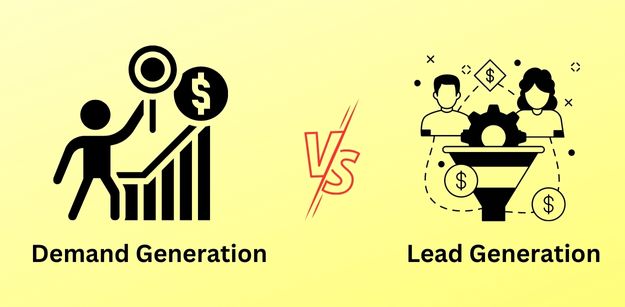Demand generation and lead generation are essential to a marketing campaign as it helps in attracting and converting target customers. Both concepts revolve around generating interest in products or services but differ in their focus and approach.
Demand generation is a broad term for marketing activities to create awareness and interest in a brand, product, or service. It focuses on generating interest in a company’s offerings before a customer is ready to buy.

On the other hand, lead generation is a more specific term that includes tactics designed to stimulate and capture interest in a company’s products or services, usually through contact forms or registration pages.
Most businesses and marketers tend to mistake one of these concepts for each, leading to an error in strategy mapping. In this article, you will learn the critical differences between demand gen and lead generation, identifying which strategy suits which and which one is the best among both marketing strategies.
What is Demand Generation?
Demand generation refers to creating market demand for a product, service, or brand. It is a marketing strategy focusing on building relationships with potential customers and generating interest in the business offerings. The ultimate goal of demand generation is to stimulate interest in a product or service, making potential customers aware of its existence, creating a connection with it, and ultimately driving them towards taking action by purchasing, subscribing to a service, or signing up for a free trial.
Demand generation involves a wide range of marketing activities, typically including content marketing, social media marketing, SEO, paid search, and other digital marketing efforts that help to create awareness. A successful demand-generation strategy requires a deep understanding of customers’ needs, goals, and pain points.
It also involves applying data-driven techniques to identify opportunities to connect with prospects at each stage of the buying process. An effective demand-generation program is critical for businesses to establish themselves as thought leaders in their industry, build brand awareness, and drive revenue growth.
What is Lead Generation?
Lead generation is identifying and attracting potential customers for a product or service. It involves collecting information or leads from people who have shown some interest in a product and may likely purchase it in the future. The primary goal of lead generation is to convert these leads into actual customers.
There are various ways to generate leads, including outbound marketing techniques such as cold calling, direct mail, and email marketing – inbound marketing tactics such as creating valuable content and search engine optimization (SEO). The lead generation process typically starts with capturing the contact information of potential customers, such as their name, email address, phone number, and other relevant details.
Once businesses have this information, they can start nurturing the leads through various marketing channels until they are ready to purchase. The success of a lead generation campaign is measured by the number of qualified leads it generates and the conversion rate from lead to customer.
What’s the Difference Between Demand and Lead Generation
Although both demand generation and lead generation may seem similar, there are fundamental differences between them, which are highlighted below:
1. Focus
Demand generation is all about building awareness, nurturing potential customers, and establishing a foundation for a long-term relationship with the company. Lead generation aims to develop interest, collect information on prospects, and get them into the sales funnel.
2. Campaign strategies
The strategies employed in demand generation focus on creating brand awareness, building content, social media engagement, SEO optimization, and email marketing. In contrast, lead generation strategies include a call to action, landing pages, gated content, form submissions, and webinars.
3. Timing and frequency cycle
The frequency of demand generation campaigns is typically low but ongoing, while lead generation campaigns are more active and produce a higher volume of leads but less regularly.
4. Collaboration
Demand generation efforts are closely linked to the company’s branding and business goals, typically involving different teams like marketing, PR, and branding. In contrast, lead generation techniques are mainly used by the sales and business development teams seeking to generate immediate revenue.
5. Metrics
Demand generation is measured by website traffic, social media presence, brand visibility, and online engagement. On the other hand, lead generation activities use metrics such as conversion rates and cost per lead.
Benefits of Demand Generation and Lead Generation
Both lead generation and demand generation are integral parts of a comprehensive marketing strategy that aims to attract, engage, and convert prospects into loyal customers.
Here are some of the benefits of implementing a robust demand and lead generation strategy:
Benefits of Demand Generation
- It helps increase brand awareness and visibility
- Generates customer interest and engagement
- Builds long-term relationships with prospective buyers
- Helps establish a company as a thought leader in its industry
- Creates a sales pipeline that can lead to recurring revenue.
Benefits of Lead Generation
- Helps identify and target qualified leads
- Shortens the sales cycle by providing targeted leads to the sales team
- Increases the efficiency and effectiveness of the sales process
- Helps build a reliable source of recurring revenue through customer retention and loyalty
- Provides valuable data and insights to improve marketing and sales efforts.
Conclusion
Although these strategies are distinct in some ways, they can be used for a well-balanced marketing campaign. With demand generation, businesses will be able to get their products or services noticed, and with lead generation, these businesses will be able to turn that interest into revenue.